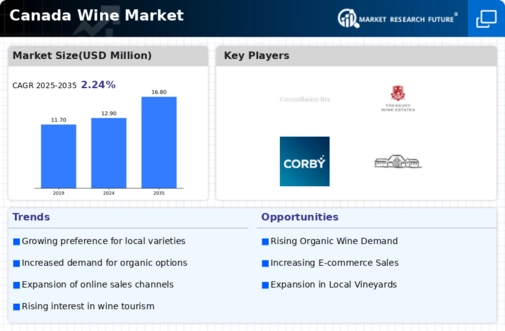Expansion of Wine Tourism
Wine tourism is emerging as a significant driver for the wine market in Canada. Regions such as British Columbia and Ontario are becoming popular destinations for wine enthusiasts, attracting both domestic and international tourists. The growth of wine tourism contributes to increased sales and brand visibility for local wineries. In 2023, wine tourism in Canada generated an estimated $1.5 billion, reflecting a robust interest in vineyard tours, tastings, and wine-related events. This influx of visitors not only boosts the local economy but also enhances the overall profile of the wine market, encouraging wineries to invest in quality production and marketing strategies.
Innovative Marketing Strategies
The wine market in Canada is witnessing a shift towards innovative marketing strategies that resonate with younger consumers. Wineries are increasingly leveraging social media platforms and digital marketing to engage with potential customers. This approach appears to be effective, as data suggests that around 40% of Canadian wine consumers aged 25-34 discover new wines through social media channels. By adopting creative marketing techniques, wineries can enhance brand loyalty and attract a broader audience. This trend indicates a potential for growth in the wine market, as wineries that effectively utilize these strategies may see increased sales and market share.
Health Consciousness and Wine Consumption
The rising health consciousness among Canadian consumers is influencing the wine market. Many individuals are becoming more selective about their alcohol consumption, often seeking wines that are perceived as healthier options. This trend includes a growing interest in low-alcohol and organic wines, which are believed to offer a more health-conscious alternative. Recent surveys indicate that approximately 25% of Canadian wine drinkers are actively seeking organic or low-sugar options. This shift in consumer preferences may lead to a diversification of product offerings within the wine market, as producers adapt to meet the demands of health-conscious consumers.
Regulatory Changes and Market Accessibility
Regulatory changes in Canada are playing a crucial role in shaping the wine market. Recent reforms aimed at simplifying the distribution and sale of wine have made it easier for consumers to access a wider variety of wines. For instance, the introduction of direct-to-consumer shipping laws has allowed wineries to reach customers beyond their local markets. This increased accessibility is likely to stimulate competition and innovation within the wine market. As a result, consumers may benefit from a broader selection of wines at competitive prices, potentially driving overall market growth.
Increasing Consumer Interest in Wine Education
The wine market in Canada is experiencing a notable increase in consumer interest in wine education. This trend is driven by a growing number of wine enthusiasts seeking to enhance their knowledge about wine varieties, regions, and tasting techniques. As consumers become more educated, they are likely to make informed purchasing decisions, which could lead to a shift towards higher-quality wines. According to recent data, approximately 30% of Canadian wine consumers have participated in wine education programs or tastings, indicating a strong desire to deepen their understanding of the wine market. This heightened interest not only supports premium wine sales but also fosters a culture of appreciation for diverse wine offerings.















Leave a Comment